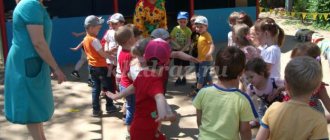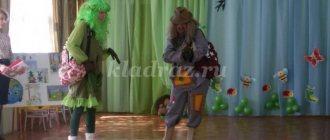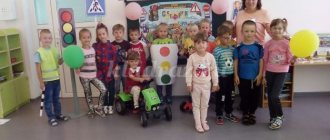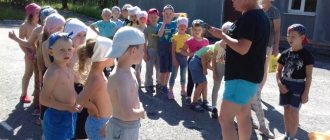Musical entertainment in the senior group “Visiting Mishenka” material (senior group) on the topic
Musical entertainment in the senior group
“Visiting Mishenka”
Tasks:
1.To promote the development of skills to highlight different parts of music. The works move according to the character of each piece.
2. Rhythmically accurately convey the melody, clearly pronouncing the words.
3. To promote the development of imagery and expressiveness of movements in children, the accumulation of music. impressions.
Equipment: Piano, music center, hero costumes, sweets, ribbons, arcs.
Progress of entertainment:
Ved: Guys, a guest will come to us today. Guess the riddle. Who is this?
He sleeps in a den in winter under a huge pine tree, and when spring comes he wakes up from sleep. (bear)
Well done! You guessed correctly. Well, where is he? Let's call him.
(the children call Mishutka).
To the music, Masha runs into the hall with a squeak and shouts:
Masha: Miiiishaaa! Where are you? (notices the children) Oh, hello! Who are you, where is Misha?
Ved: We are also looking for Misha. They wanted to say goodbye to him before he went into hibernation, but he was nowhere to be found.
Masha: Do you even recognize me? I'm Masha. I'm hurrying to my Mishki. Why are you so sad? Let's congratulate Mishka together
Ved : What should we congratulate Misha on?
Masha : Don’t you know, it’s Misha’s birthday today!
Ved: We didn’t even know, we didn’t prepare anything for Misha.
Masha: Oh, you, but I prepared him some treats. Maybe we can go together to congratulate Misha? Then we will go with you on a journey on a train. Do you agree? Now take your seats one after another:
Hurry up and get into the trailers. The time is approaching, the train is leaving.
Children pretend to be a train, walk one after another and say: “chug-chug, chug-chug, tu-tu.”
Walking with obstacles
“The train goes through a tunnel” - climbing under high arches.
“The train accelerates and slows down” - walking with a transition to running.
Masha : Stop, stop!
The train won't go up the hill, we need to get on the plane. The plane flies and flies... A brave pilot sits in it.
(Children stand, legs apart, arms to the sides. Tilts left and right, depicting the movements of an airplane to the sound “U-oo-oo”).
Masha: Finally, we have arrived. I can already see his hut in sight. And while we haven’t gotten to the end yet, I prepared ribbons for us, they are so beautiful, look (shows)
We'll play with ribbons and surprise Mishutka.
"Ribbon Game"
We will play with ribbons, we will wave ribbons (children run around waving ribbons). We played and played - our ribbons were tired (walking, hands with ribbons hidden behind our backs). Ribbon-ribbon, show yourself, spin around with us (spin around, arms raised up). Let's go through the stream, we'll take the ribbon with us (walking, raising our knees high). So the wind blew and scared away our ribbon (children blow on the ribbons, then wave them in front of them).
Dance with ribbons on display.
Masha : Well, let's call Misha.
In chorus : Misha! Misha, Misha!
Misha : Oh, I have guests. Hello guys!
Summary of musical entertainment for children and parents “Let's play together”
SUMMARY OF MUSICAL ENTERTAINMENT FOR CHILDREN AND PARENTS OF PREPARATORY GROUP “PLAYING TOGETHER”
Target:
Establishing emotional contact between teachers, parents, children in joint musical activities
Tasks:
1. Expand parents’ understanding of the benefits of outdoor games.
2. introduce fun and useful outdoor games,
not requiring material costs for materials and equipment
3. To develop in children goodwill, communication skills, and the ability to work in a team.
3. Improve musical and rhythmic skills.
4. Strengthen parent-child relationships.
Progress of entertainment:
Music director:
Hello, dear parents!
Hello guys! Today we gathered in this room to play, have fun and maybe learn something new. Guys, do you like to play on a computer, phone or tablet? (Children's response)
But your parents did not have such toys and they had to go outside and play there.
Let's ask your mom and dad what games they loved the most? (Parents' answers).
That's how many different games there were, but that's not all.
Guys, would you like to play with your parents? (Children's answers).
Parents and their children are invited to play active and sedentary musical games , which they can later organize with their child at home .
"Live Piano" (sedentary game)
All participants sit in one row (parent, child) and place their hands on their knees. To the music, each participant takes turns, one after the other, slapping their knee with each hand. At first the game is played at a slow pace, each time the pace accelerates.
Game "Stream"
A driver is selected, the rest are divided into pairs, preferably opposite sexes, and clasp their hands.
Couples stand behind each other, forming a corridor and raising their hands up.
The driver enters the formed corridor from one end and moves to the other end of the corridor, choosing a mate along the way.
He takes the person he likes by the hand, uncoupling the standing couple. The new couple goes together to the end of the “stream” and stands there with their hands raised.
The freed player becomes the driver, goes to the beginning of the “stream” and enters the corridor, choosing a person for a couple and so on until everyone gets tired of playing.
If there are a lot of people playing, there may be several drivers.
"The king walked through the forest"
Children join hands and form a circle. In (boy, dad, grandfather), he holds a homemade crown in his hands. Everyone dances around the “king” and sings: The king walked through the forest, through the forest, through the forest, Found himself a princess, princess, princess. (“the king” chooses the “princess” and puts a crown on her head)
Let's spin around, let's spin around.
let's spin, (everyone is spinning)
And forever be friends, let's be friends, let's be friends
(everyone waves their hand)
Let's clap with our hands, clap, clap,
(clap our hands)
Stomp with our feet, stomp, stomp,
(stomp with our feet)
Shake our heads,
(shake our heads)
Let's start first !
(the girl gives the crown and returns to her place)
The king was walking through the forest, ...
(“the king” chooses a new “princess”)
Game “Silent Singing”
The presenter invites everyone to sing a famous New Year's song. At the first clap, all participants begin to sing loudly in chorus, at the second, the singing aloud stops and everyone sings to themselves. The third clap serves as a signal for everyone to sing out loud again. Can you imagine what a “harmonious” choir you will hear? In general, you won't be bored. The singing is very fun and the playing is fun.
Game "Burners" (Burn, Burn Clear)
Children form a circle. The driver (child) walks inside the circle to the chant. The children all say the chant together: “Burn, burn clearly so that it doesn’t go out, look at the sky, the birds are flying, the bells are ringing.” As soon as the chant ends, the driver approaches the children and waves a handkerchief between the two children, as if separating them. These two children run in different directions, running around the circle outside. And they return to their place and leader. The one of the “runners” who reaches the leader first, snatches his handkerchief and becomes the leader himself. Music director:
This was our last game.
Tell me guys, did you like it? (Answers)
I really hope that now outdoor play will not be a rare guest, but will settle in yours forever.
And the booklets will help you master a large number of outdoor games and spend fun and useful time at home and on the street at any time of the year. Participants are given thematic booklets.
On the topic: methodological developments, presentations and notes
It is such entertainment that introduces children to Orthodox culture and helps plant the seeds of universal human values.
Summary of musical entertainment in the senior group “Russian heroes”.
Entertainment scenario for the senior group “AUTUMN KALEIDOSCOPE”.
Scenario of joint entertainment with parents for Mother’s Day “MY MOTHER”.
Musical entertainment in the senior group “Autumn Kaleidoscope”.
Musical entertainment in the senior group “MY MOTHER”.
The content of the summary assumes, as a final result, the development of musical hearing in children and a sense of rhythm. Children go on a journey, during which they complete interesting tasks for each.
Entertainment and holidays in the musical development of preschool children
Introduction
According to experts, all children are naturally musical, and preschool age is a sensitive period for the formation of abilities, including musical ones. It has been noticed that constant communication with music awakens in a person a keen observation of the voices and harmonies of nature, instills the ability and need to associate various phenomena of the surrounding world. The level of musical culture among preschoolers is very low - this is a problem today. Holidays and entertainment, developed on the basis of theoretical and practical research, provide invaluable assistance here. They have a huge influence and significance on the musical development of a child. The purpose of our work was to study the importance of entertainment and holidays in the musical development of preschool children. We set the following tasks: 1) determine the importance of entertainment in the musical development of children; 2) consider the types and forms of entertainment, their organization and conduct;
3) reveal the use of music in entertainment provided by the teacher;
4) substantiate the significance of holidays in the musical and aesthetic development of preschool children;
5) outline the role of music at children's parties; 6) highlight the main points of preparation for the holiday for children, teachers and employees of preschool educational institutions and the role of music at children's parties; 7) develop a script for one of the forms of entertainment provided by the teacher, including music.
- The importance of entertainment in the musical development of children.
Entertainment represents the most exciting events in children's daily lives. Delivering joy and aesthetic experiences. They, first of all, are a means of aesthetic development of the child, since they use various types of arts, and also contribute to the development of children's interest in music. Entertainment using music is the most important means of introducing children to musical performances and improving musical perception. “Entertaining - educating” - this principle, as you know, is widely used in kindergartens. Entertainment helps to show children interesting sights, bring joy, and give them the opportunity to show independence and creative activity. Their use expands the sphere of pedagogical influence on the comprehensive development of preschool children and contributes to the manifestation of positive personality traits. Entertainment broadens children's horizons, knowledge about music, and increases interest in it. In an interesting form, children more easily perceive the nature and content of a musical work and movement; they become more active and creative, since the saturation of entertainment with emotional and entertaining moments increases the interest, and, consequently, the activity of children in everything that is offered to them during entertainment. The collective experiences of children form in them the rudiments of social feelings and relationships. Music in entertainment is used in different ways: in one case it constitutes the main content (musical games, concerts, children's operas, round dances, choreographic miniatures), in another case it is used partially (performances, dramatization games, compositions). It is important to skillfully select music for entertainment, taking into account their pedagogical orientation and music, with simple, memorable and favorite melodies. [5]. Thus, music in entertainment is of great and paramount importance.
- Types and forms of entertainment, their organization and conduct.
A puppet theater is easy to organize in every kindergarten: almost all dolls can be bought at a toy store, made with your own hands, and a screen can be made with the help of a carpenter or parents. Music precedes the performance or serves as a setting for its individual moments. Rarely does a performance take place without singing and dancing puppets. Shadow theater. It is played not by three-dimensional dolls, but by silhouette dolls. Children love to sing along with the performers of familiar songs and watch how the dark figures of people, animals, birds, and beasts move on a brightly lit screen. Musical performances of this theater can either be performed entirely with children singing, or with the soloist and choir singing alternately, or with an adult singing. Shadow theater is the presentation of a skit, a poem, a short fairy tale through the reflection of the shadow of finger manipulations on a wall or a white screen.
Tabletop toy theater. For it, ordinary three-dimensional toys or figurines made of cardboard and plywood are usually used. The teacher manipulates toys with his hands. So that the children can see everything clearly, they are seated in a semicircle in front of the table - the stage. Fairy tales, stories, nursery rhymes, and poems that are usually familiar to children are staged. The text of the dramatization must be well learned by the “actors”. The musical material for tabletop theater performances are small songs and jokes. Sometimes they show, using recordings, only individual movements: hares jump, cats wash themselves, dolls dance.
The theater of fingers (bi-ba-bo) does not require special equipment: a high screen, scenery, curtain, etc. The main thing in this theater is the heads of the puppets, with which you need to carefully rehearse the scenes or plays selected for the show. You can purchase it at the store or make the doll heads yourself from paper, papier-mâché, potatoes, cloth, table tennis balls, etc.
Staging on flannelgraph has been successfully used in kindergarten. Using a flannelgraph, it is recommended to stage any fairy tales with not too dynamic action, stories about nature - flowers, trees, birds, animals. The performance can be accompanied by music appropriate to its content. Flannelograph is applicable in all groups without exception.
Listening to radio broadcasts. Listening to fairy tales, stories, and music can play a big role in the aesthetic development of children. The perception of radio broadcasts is complicated by the lack of visually specific images, so adults must explain to children who is speaking. After the program, it is necessary to exchange impressions with the children to find out how they understood its content. A culture of behavior should be cultivated: children should be taught to listen carefully without disturbing their friends. Watching TV shows is not very common in kindergartens, primarily because TV channels set aside too late a time for preschoolers. Basically, TV shows can be watched with children from night groups in the evening hours.
Showing filmstrips is a very good entertainment for children. It is conducted by the teacher himself, who can hold any frame on the screen and draw the children’s attention to the most interesting details. During the viewing process, the teacher helps children understand the content of the filmstrip and form a certain attitude towards the actions of the characters. Recently, filmstrips with records have begun to be produced, which further increases the effectiveness of the display.
Concerts are organized by invited artists, former kindergarten students, students of music schools, adults, as well as children attending kindergarten. They present various types of arts - artistic expression, music, dance. Sometimes concerts consist only of musical works. When you get acquainted, for example, with certain musical instruments - domra, button accordion, balalaika, violin, etc. - you can play musical pieces on them and sing to their accompaniment. Evenings of children's amateur performances have the character of a home concert celebration. They do not require special preparation for children, since they include songs, dances, poems, and games learned in everyday classes. Children can perform individually, in groups of several people, or, if they wish, all together. The teacher only arranges the sequence of children’s performances, taking into account the change in types of musical and literary activities.
Celebrations of children's birthdays are usually held in the circle of their group, but sometimes in the hall. At these evenings, children sing songs at the request of the heroes of the occasion, perform their favorite dances, play games, and recite poems. Usually at the end of the evening, children give homemade gifts to the heroes of the occasion, and then drink tea. Evenings of sports games and entertainment may consist of children's favorite non-plot musical games; attraction games; sports games with tasks that develop dexterity and ingenuity; outdoor games with competitions. The program of these evenings often includes sports-themed songs and marches. For example, the game “Competition”, music by F. Gershova, consists of marching, running, arm exercises, squats, playing with an imaginary ball, jumping over an imaginary rope, and calm walking.
Dramatizations of fairy tales, short stories, poems, musical works, and theatrical performances involve children’s gradual assimilation of the material. These types of entertainment go very well with creative play, in which the child quickly masters the peculiarities of the movements of individual characters and remembers the text. Children love to learn fairy tales, songs, stories and perform “theatrical performances” in front of “spectators.” There are special musical fairy tale operas written for children.
Evenings of games, fun, attractions. Riddles, funny humorous poems, ditties, nursery rhymes and tongue twisters, simple attractions (“Bonfire”, “Who can tie a scarf for your sister the fastest”, “Lay the table”, etc.) bring children great joy and untold pleasure. These evenings can also be spent in the form of an exciting game. When drawing up a program for evening entertainment, you should take into account the workload of children, skillfully alternate spectacular moments with games, tasks that need to be thought through, with dancing, and attractions. Evenings of entertainment should be presented in the musical director's perspective and in the teacher's calendar. They are carried out once every 7-10 days, 3-4 times a month. In summer - weekly. Their duration can vary: from 5-7 to 30-45 minutes, depending on the age of the children and the content of the material. It is very important that evenings of various types of entertainment are held throughout the year and that all children attend them both as actors and as spectators [2]. Thus, the world of entertainment is very diverse and each has its own characteristics and focus not only in content, but also in organization and conduct.
3. The use of music in entertainment provided by the teacher.
Music in entertainment is used in different ways: in one case it constitutes the main content (musical games, concerts, children's operas, choreographic miniatures, round dances), in another it is used partially (performances, dramatization games, musical and literary compositions). But in all cases, it is necessary that expediency be observed in the use of music: either as a leading element that determines the basis of entertainment, or as a means that enriches and complements the content. New pieces of music should not be used frequently. Children's recognition of familiar melodies in situations unexpected for them or in an unusual environment causes an emotional uplift and helps expand their musical understanding. Incorporating familiar songs, dances, and games learned in class will bring them genuine pleasure and joy. As a rule, in entertainment, music is either performed by adults (songs, instrumental pieces) or performed by children (songs, dances, games, etc.). In this case, it is important to take into account the principle of accessibility: in the first case - for its perception by children, in the second - for its execution by children. However, it should always be bright, imaginative music, with a simple, memorable melody, and a fairly expressive arrangement. You can also use a recording. The solo, choral and orchestral sound of music performed by musicians and famous choirs contributes to the development of aesthetic perception of music. It can also be a separate musical fragment, representing a complete musical form. It is advisable to include music on any sound-reproducing devices (tape recorders, electrophones) in order to design theatrical performances, when creating a general musical or rhythmic background characteristic of certain types of entertainment [3]. Thus, the use of music in entertainment conducted by the teacher has its own characteristics and direction.
- The importance of holidays in the musical and aesthetic development of preschool children.
A special place in the education of preschool children is occupied by the holiday, one of the main goals of which is the formation of various emotions and feelings, which are the most important condition for personal development. The holiday combines various types of art: music, literary expression, dance, dramatization, visual arts; therefore, first of all, it develops in children aesthetic feelings, an aesthetic attitude towards the surrounding reality [4].
A children's holiday is an important part of a child's life; it is a joyful event that allows you to relax, shake yourself up, forget, and sometimes just take a break from everyday life. And the words have almost become an aphorism: “There is no childhood without holidays!” Holidays spiritually enrich a child, expand his knowledge about the world around him, help restore old and good traditions, unite and encourage creativity. [1]. The holiday is a speech environment that is so necessary for children; an excellent situation for activating speech and its communicative function. The holiday reveals the richest opportunities for the comprehensive development of a child. This is the joy of communication, the joy of creativity and co-creation, self-expression, the joy of mutual enrichment, emancipation and [6]. The musical activity of children occupies the main place at matinees. This determines the special role of the musical repertoire and the requirements for its selection. The significance of the matinee as one of the means of aesthetic education is determined not only by the influence of music, but also by the combination of various types of arts in it, which complement each other in solving one topic, which makes it possible to express it most fully. The bright, artistic decoration of the hall creates solemnity, pomp and immediately puts children in high spirits when they enter the hall. An emotional upsurge is created by the greeting of the host who opens the holiday. In the poems that children read, the roll call most fully and specifically conveys the main idea of the holiday [3]. Thus, the holiday carries a special musical and aesthetic load on the development of a preschooler
5. The role of music at children's parties.
Music, having a great power of emotional impact, creates the appropriate mood in children: solemnly elated, calm, cheerful. First, it is necessary to create a general upsurge of feelings, to bring to the consciousness of children the main idea of the holiday. As the action progresses, the musical accompaniment of the holiday varies and depends on the content of the next performance. The sounds of a cheerful march set the children up for a festive procession. The playful nature of a dance melody or a calm, lyrical song evoke a corresponding emotional response. Music deepens the artistic images of the poetic text, evoking in children a feeling of empathy for the content of the song. The musical repertoire used at matinees is quite diverse. Its choice is dictated, first of all, by established general principles: it must meet educational objectives, have artistic value and be accessible for children to perform. It is selected in accordance with different types of musical activities - singing, musical games, dancing and staging. For this purpose, songs, plays by Soviet composers, and folk melodies are selected. The content of the musical repertoire is determined by the theme of the matinees [3]. Thus, music at holidays has a deep and powerful impact.






